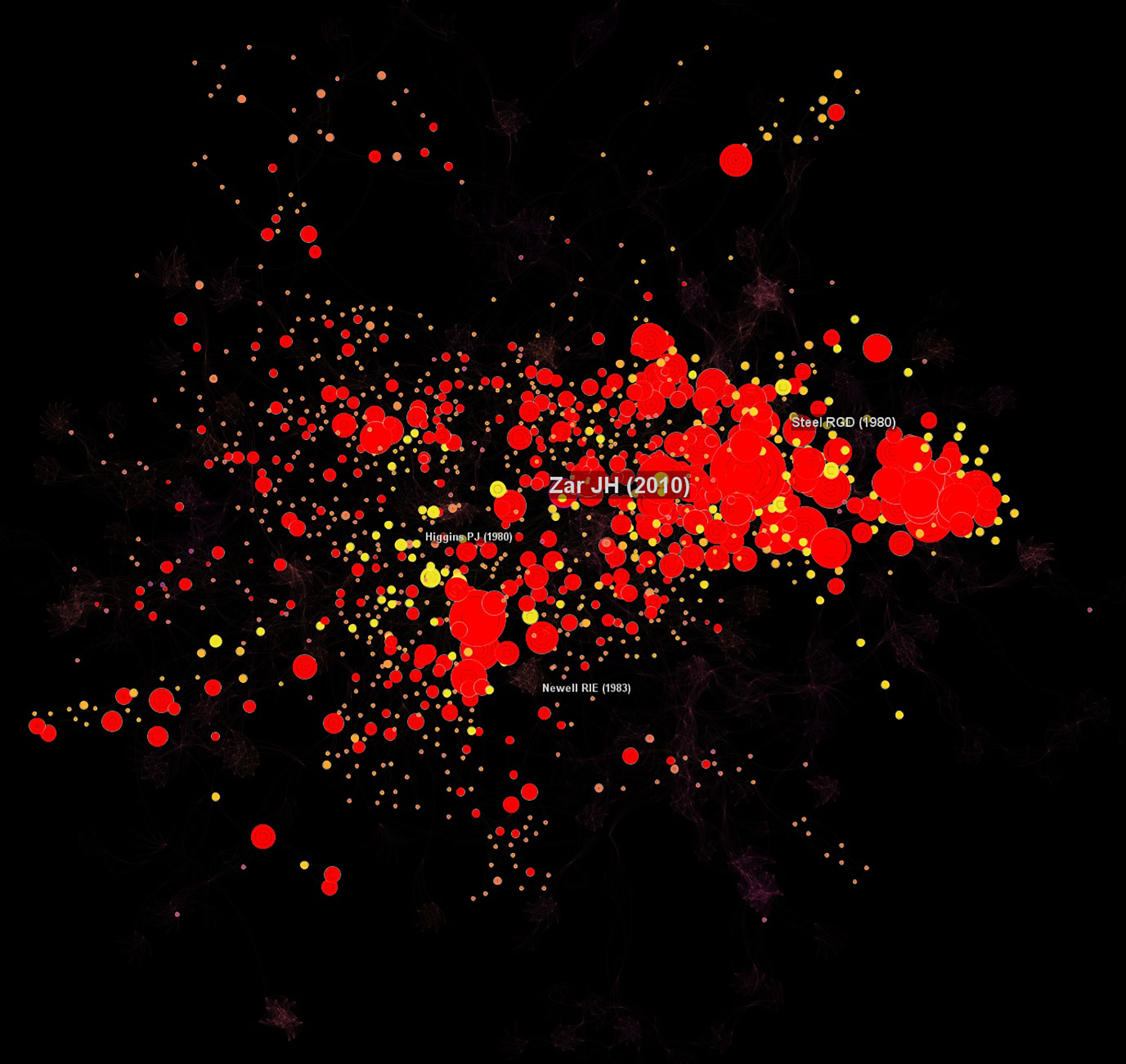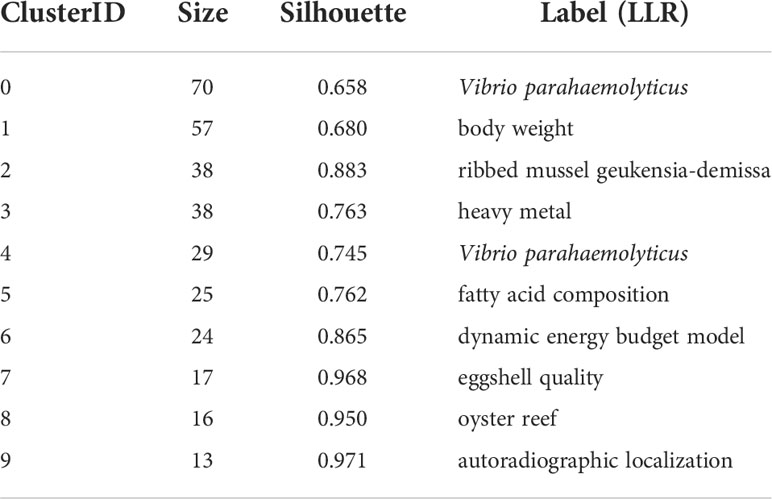- 1Institute of Marine Biotechnology (IMB), Universiti Malaysia Terengganu (UMT), Kuala Nerus, Terengganu, Malaysia
- 2Climate Change Adaptation Laboratory, Institute of Marine Biotechnology (IMB), Universiti Malaysia Terengganu (UMT), Kuala Nerus, Terengganu, Malaysia
- 3Institute for Biodiversity and Sustainable Development, Universiti Teknologi MARA (UiTM), Shah Alam, Selangor, Malaysia
- 4Faculty of Business Management, Universiti Teknologi MARA (UiTM) (Pahang), Raub, Pahang, Malaysia
- 5Institute of Chemistry, University of Tartu, Tartu, Estonia
Oysters form extraordinary ecosystems (e.g. oyster reefs) with a high economic importance (e.g. aquaculture) to the world’s aquatic ecological systems. Shellfish, especially mollusks, have a significant contribution towards the future global food security. However, to the best of our knowledge, there are no bibliometric studies on oyster-related topics. In the present study, we queried the Web of Science Core Collection (WOSCC) database to selectively identify the scope of oyster publications. Citespace was used as a tool for the co-citation analysis and Microsoft Excel software for the handling of descriptive datasets. A total of 19,202 papers available from WOSCC between 1975 and 2021 were extracted and analyzed. Our data indicated that the number of publications increased two-fold between 2010 (654) and 2021 (1309). Our study also revealed that almost 70% of the publications were published by the five countries that lead oyster research in the world, USA, China, France, Australia, and Japan. Over the last five decades, there are a total of 7,905 participating institutions, a tremendous 40,939 authors involved, and 2,319 different journals published about oyster related studies. To the best of our knowledge, this is the first scientometric review to identify the scope of oyster research and publications. These findings show the emergence of oyster research and could attract various stakeholders, especially the early career researchers in various fields to collaborate in oyster research in the future.
Introduction
Oysters have become a species of great ecological and economic importance for the world’s aquatic system and services. For example, oyster reefs and aquaculture activities within coastal areas have significantly contributed to world species biodiversity and food sources. Shellfish, such as mollusks (e.g. mussel, oyster, clam) or crustaceans (e.g. crab, lobster, shrimp) play an important role in the sustainability of future food protein, especially for aquatic products. Future food sustainability has been characterized by Azra et al. (2021), identifying a need for adequate supply sources, environmentally friendly production methods, and low production costs. Oysters are among potential future sustainable food candidates due to their: (i) versatility towards climate change (Cole et al., 2016; He et al., 2021), (ii) high availability for biological (e.g. reproduction) and technical knowledge (e.g. culture) (Wilson et al., 2015; FAO, 2022), (iii) short life cycle and broodstock maturation period (compared to some finfish species, such as grouper) (Zhang et al., 2019; Barman et al., 2022) and (iv) high nutritional value and health benefits (Venugopal and Gopakumar, 2017; Ma et al., 2022).
Previous reviews about oyster literature have focused on various research fields. For example, the ecological impacts of increasing oyster aquaculture at the grow-out stage in estuarine areas (Forrest et al., 2009) and their ability to be an ecosystem engineer driver in aquatic environments, especially as filtration organisms (Ehrich and Harris, 2015). Botta et al. (2020) showed the current trends of oyster aquaculture production and its global consumption, while a comprehensive review by Hao et al. (2022) suggested functional development and utilization of oysters could be used as a healthy protein source, especially in the form of polypeptides (also known as oyster peptides). Additionally, there are also various popular and recent review about oyster’ ecology, ecosystem benefits and restoration potential in various type of oceans, environments and conditions (Brumbaugh and Coen, 2009; Pritchard et al., 2015; Hernández et al., 2018; Pogoda et al., 2019; Reeves et al., 2020; Howie and Bishop, 2021; Richardson et al., 2022).
However, a global statistical analysis of bibliometric reviews, especially one focusing on scientometric-based studies of oyster research, is still lacking. Previous bibliometric analysis also has been done on the mapping of oyster species (Guo et al., 2016), however, there is still no co-citation software being established for the analysis of oyster publication, especially through the scientometric techniques. The scientometric analysis, a visualized statistical method of the published literature, is among one of the most used methods in identifying the current trends and research gaps in a database (Azra et al., 2022; Chen, 2022; Kulkarni and Edwards, 2022). It incorporates various software(s) or tool(s), such as: CiteSpace, VOSviewer, ScientoPia and HistCite (Kim and Zhu, 2018; Chen and Song, 2019; Ruiz-Rosero et al., 2019; Li et al., 2022).
Thus, the aim of this study was to identify current oyster research and publication trends as well as hot research topics throughout the literature over time. We also assessed the regional distribution of articles, open access options, major contributors to the field in terms of affiliations, authors, and publication sources. Finally, we used co-citation, cluster and keywords analysis to further explore this research field.
The scientific findings from the present study are expected to contribute towards the identification of rapidly growing subject areas related to oyster research, understanding the network patterns and tracking research hotspots, especially for early career researchers.
Methods
We queried the Web of Science Core Collection (WOSCC) database to selectively identify oyster related publications, conducted on 16th July 2022 (https://www.webofscience.com/wos/woscc/summary/338bf0d0-9222-498d-b89c-913a7d614ca7-43aecf9b/date-descending/1). Early access articles in 2023 or articles published in 2022 were excluded. We used CiteSpace, a scientometric analysis tool, as well as Microsoft Excel 2019 to handle the descriptive dataset. The methodology of our literature search is summarized in the flowchart in Figure 1. In CiteSpace, there are few terms used such as centrality, burst detection, co-citation, and sigma score. The details of each term are defined on the CiteSpace official homepage (https://citespace.podia.com/glossary). Briefly, centrality refers to understanding relationships between different clusters holistically and burst detection is also known as the frequency surge of a particular type of event (i.e. field or knowledge). Co-citations refer to when two different references are cited by a third article, and sigma measures rapidly growing nodes.
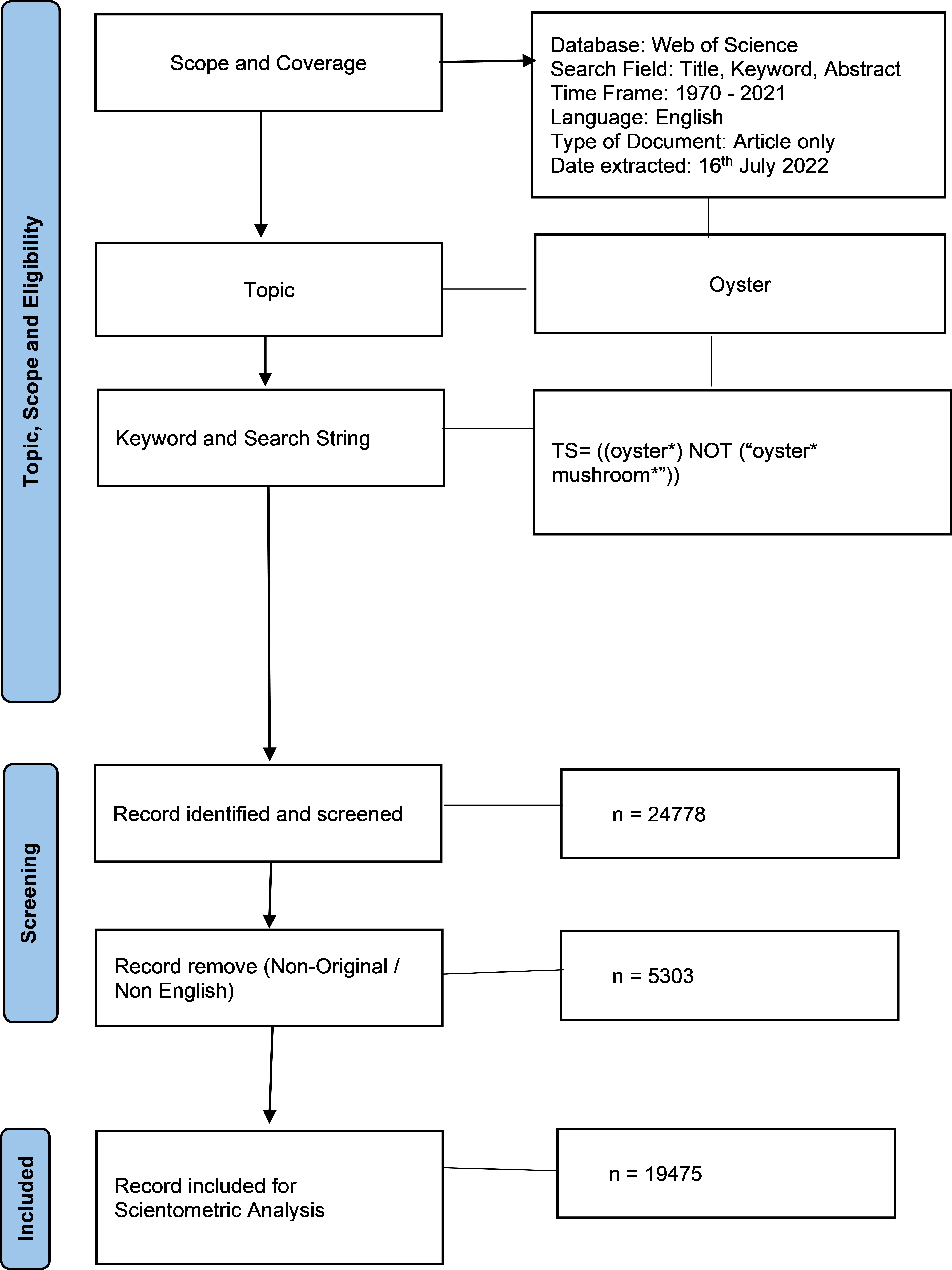
Figure 1 The flowchart or also known as methodological framework of the present study on aquatic shellfish of oyster.
Results
Publication trends and regional distribution
There were 19,202 published articles related to oyster research within WOSCC between 1975 and 2021 (Figure 2); we also identified 148 regional or states involved in this field (Figure 3). Less than 20% of total publications were not under the open access option, as mentioned in the WOSCC database (Figure 4) (https://webofscience.help.clarivate.com/en-us/Content/open-access.html). Over the last five decades, there were 7,905 participating institutions, 40,939 authors involved, and 2,319 different journals. The contributions for each are listed in Table 1.

Figure 2 Publication trends of oyster research between 1970 until 2021, with 2010 to 2021, the number of papers increased rapidly.
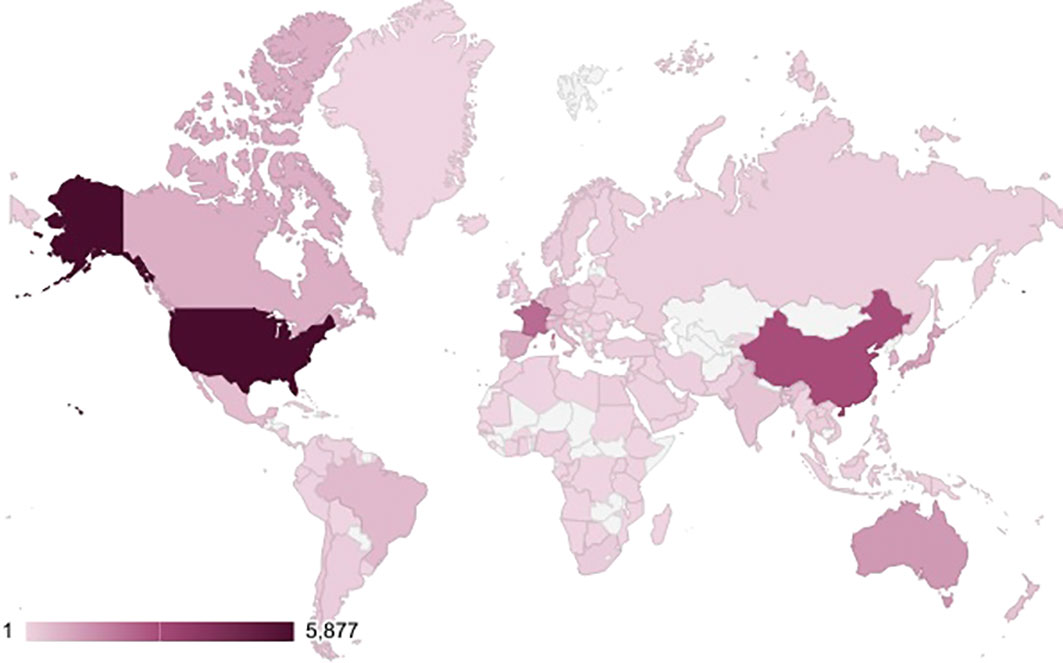
Figure 3 Regional and state distribution of oyster research in the world, dark magenta represents the highest total number of publications, whereas lighter shades represent fewer publications.

Figure 4 Level of Open Access of the generated literature on oyster research, based on the Web of Science Core Collection database between 1970 until 2021.
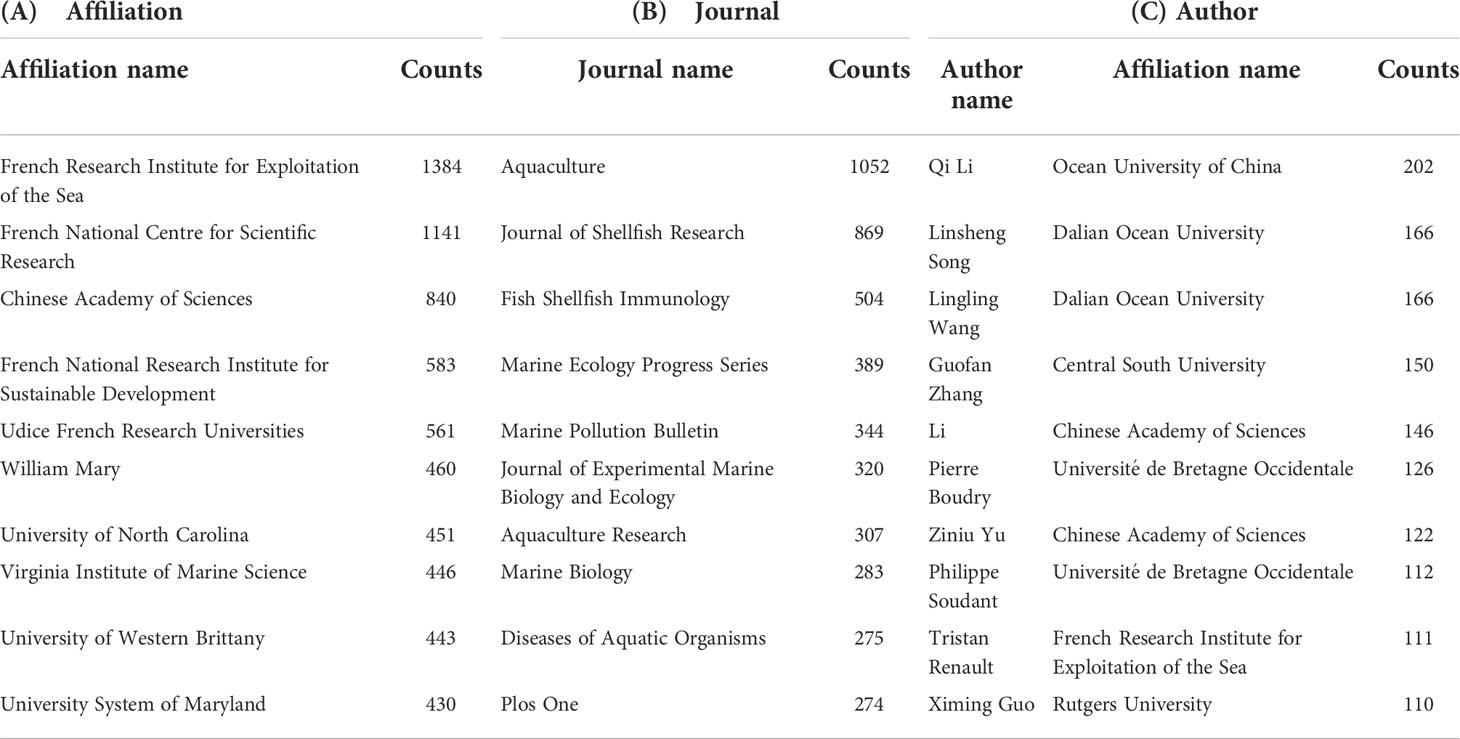
Table 1 Top ten contribution (i.e. author, journal and affiliation) of oyster research in the world, based on the Web of Science Core Collection.
Scientometric results
Author and document co-citation analysis
Figure 5 shows the author’s co-citation analysis for oyster research based on the Web of Science Core Collection database, only including authors with centrality scores greater or equal to 0.1. Together with the document co-citation analysis in Figure 6 (also based on centrality scores ≥0.1), these analyses showed there are only four different authors and articles that are influential in oyster research.
Document cluster analysis and keyword burstiness
Our analysis generated a total of 34 co-citation clusters, although only the 23 top clusters are shown in Figure 7. The most recent cluster is Cluster ID #1 ocean acidification, whereas the top cluster is #0, ostreid herpesvirus. Keywords such as American oyster and crassostrea gigas were among the top and most keywords found in oyster research, identified through the CiteSpace analysis (Table 2; Figure 8).
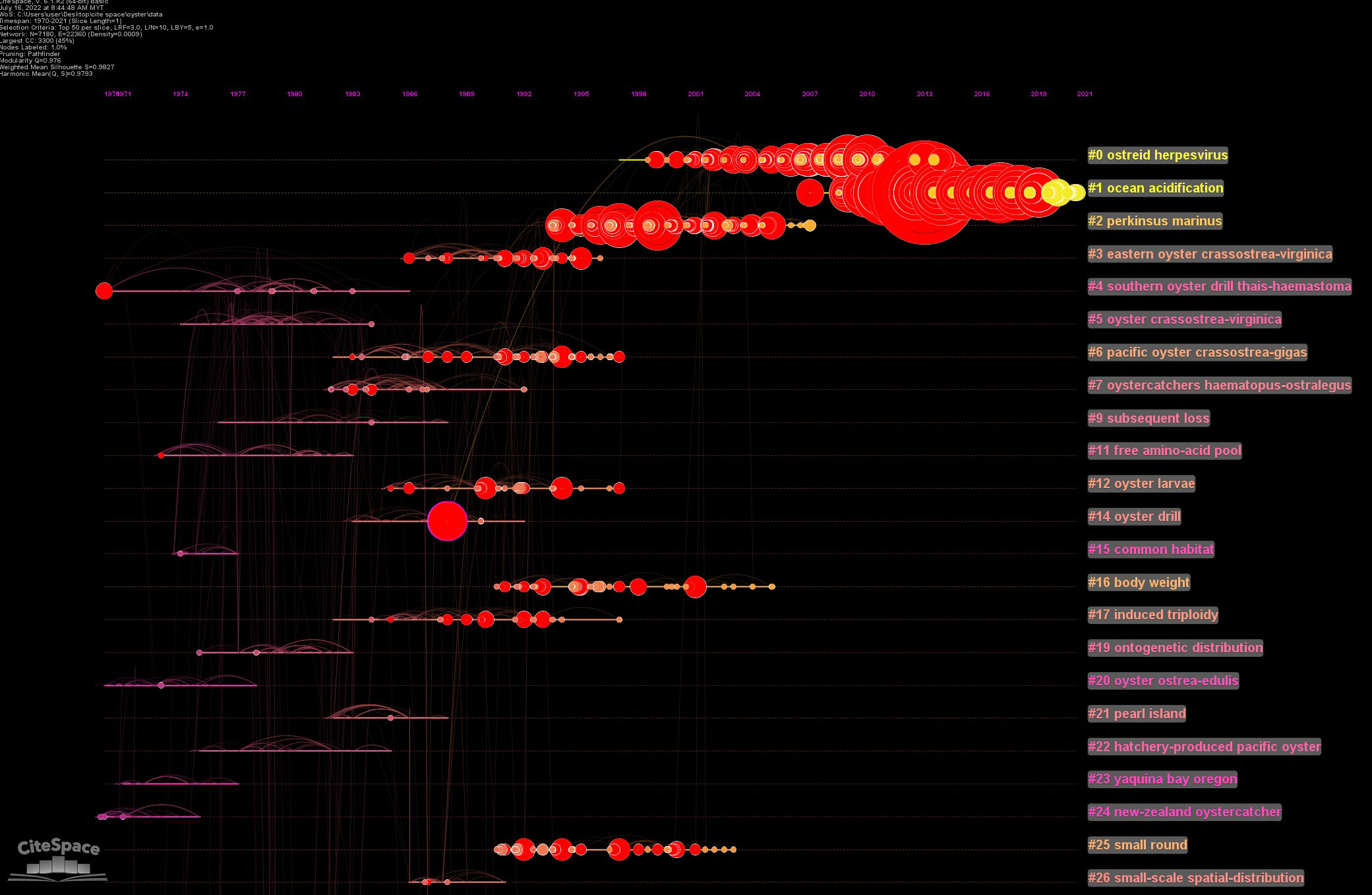
Figure 7 Summary of identified document cluster lifetimes in oyster research from 1970 to 2021 generated from the CiteSpace.
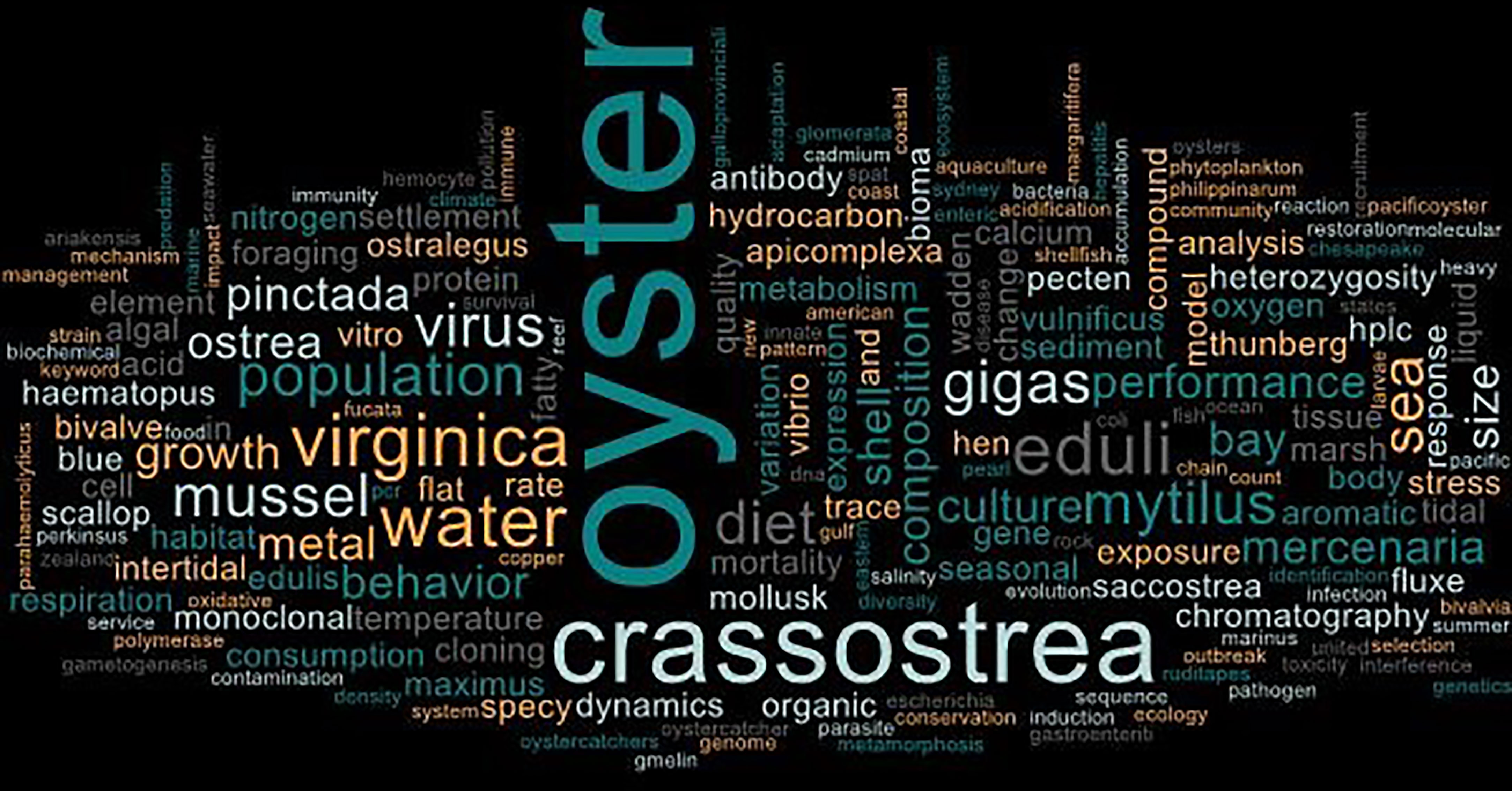
Figure 8 Keyword distribution, generated by the Pro Word Cloud by Microsoft PowerPoint 2019 computer spreadsheet software.
Discussion
Oyster’s global publication trends
We identified the major developments of oyster research over the last five decades through scientometric macroanalysis on 19,475 articles accessible through the Web of Science Core Collection database. The mean number of articles per year was 375 (1970-2021). The extraordinary total number of publications, affiliations (7,905 institution) and authors involved (40,939 authors) in the field shows that bivalves, especially oysters, are among one of the most-studied marine organisms in the world. We did not have any marine based scientometric studies to compared, and thus limits the discussion section for this particular subject. With commercial interest increasing and many preprints available at the time of our study (https://www.preprints.org/- when searching for keyword oyster - 553 articles and compared to the keyword lobster - 250 articles), we expect this trend to continue. Preprints make early versions of non peer-reviewed articles permanently available and citable, until they become peer-reviewed. The great interest in oysters we identified here could be due to the fact that oysters play vital roles in ecosystems and are commercially harvested organisms with great economic importance, (Dumbauld et al., 2009; Fleury et al., 2009; Reeder-Myers et al., 2022; Smith et al., 2022).
The present study also found that 80% of the retrieved articles are considered open access, strongly supporting the growing interest of science as a whole towards making research openly accessible. The fact we identified 148 different countries or regions contributing to oyster research additionally demonstrates the importance of oyster research in the global scientific community. As for affiliations involved in the field, French institutions were among the top institutions actively involved, as referred in Table 1. Half of the top ten institutions participating in the field originated from France. Correspondingly, French and Chinese authors were also among the top ten active authors in oyster research. Aquaculture, Journal of Shellfish Research and Fish Shellfish Immunology were among the top three journals that published oyster related work, which is not unexpected due to the importance of culturing oysters.
Global collaborative networks
Our scientometric based analysis also identified main collaborative networks of authors, and documents. Author co-citation analysis in Figure 5 showed that there were only four influential authors in oyster research. Brian L. Bayne from the University of Sydney, Australia and Thomas C. Cheng from Lehigh University, U.S.A were the top two most influential authors with the sigma score of 0.18 and 0.16, respectively. This is because both researchers (Bayne BL and Cheng TC) actively published about bivalve research in the world, as early as 1969 and 1967, respectively (refer to Supplementary Materials for more details). The data showed that Bayne Bl and Cheng TC published a total of 24 articles and 34 articles, respectively in the document citation analysis (the co-citation analysis between articles published in WOSCC). This could suggest that both researchers published as early as the nineteenth century, as they may be used by other researchers as primary references by subsequent publications.
Jerrold H. Zar (marked as Zarr, 2010 in Figure 6) from the Northern Illinois University and Robert George Douglas Steel (marked as Steel and Torrie, 1980 in Figure 6) Carolina State University, both from U.S.A were among the most influential authors for the document co-citation analysis (i.e. co-cited documents). Zar (2010) published about the broad statistical methods and analysis of data from diverse areas of biological studies. Likewise, Steel and Torrie (1980) (referred to Steel and Torrie, 1980 in the reference section), published about the principles and procedures of statistics through the biometrical approach. Both studies are not directly related to the oyster research, and this indicated that there was no available literature that is mostly influenced by scientometric studies related to oyster research in the world. This could be due to the fact that there was a lot of literature available that falls directly under the oyster research, as indicated by the red dot in Figure 6. For example, the study by Newell and Jordan (1983) and Higgins (1980) were among the top articles in oyster research, based on the document co-citation analysis. Both articles discussed food availability and feeding behavior in the oysters, especially America oyster, Crassostrea virginica. Newell and Jordan (1983) found that a custom combination of artificial diet of silt and marine green algae, Tetraselmis suecica, are able to reduce about 50% of pseudofeces activities in C. virginica. Meanwhile, the Higgins (1980) study about the effect of algal food availability on the oyster’s valve movements at different seawater and fed conditions. Both earlier studies in 80’s era are importance in order to understand the basic biology of the oyster for future potential of aquaculture industry or ecosystem benefits (Chan et al., 2022).
The cluster analysis over time (Figure 7) showed that climate change elements (ocean acidification) and disease issues (herpesvirus of Ostreid herpesvirus and pathogen of Perkinsus marinus) were among the top three clusters that are important to oyster research. It is well known that both O. herpesvirus and P. marinus have been associated with the worldwide mortality in bivalve species, especially oysters (Renault et al., 2014; Carnegie et al., 2021). Previous reviews also indicated that the climate change issue of ocean acidification has impacted oyster cultivation, especially in the coastal areas (Lemasson et al., 2017; Zhang et al., 2022). Further collaboration between countries, institutions and authors are truly needed, focused more on these issues of climate change and disease. Furthermore, any future research on oysters could be based on impactful keywords (Table 2; Figure 8). Impactful keywords such as crassostrea gigas, pacific oyster, and American oyster showed that these are also important species or animals to the field of oyster research. This could be the fact that these species are more established in their basic biology and culture techniques (Beckensteiner et al., 2020).
Based on the Table 3, the top ten cluster analysis based on the given keyword of the oyster research have been analyzed. Cluster analysis is performed on the keyword taken from “Title”, “Abstract” and “Keyword” of each selected articles (n=19,202). Ten significant group clusters were discovered and each row in Table 3 represents a different research topic based on the keyword. The clusters were numbered and ranked in order of size, with #0 being the largest. “Vibrio parahaemolyticus” is the largest cluster with 70 keywords. Most of the keyword are focused on the physiological related studies such as body weight, fatty acid composition, dynamic energy budget, eggshell quality and autoradiographic localization. Less studies focused on a few issues such as disease related issue (Vibrio parahaemolyticus, Vibrio parahaemolyticus), pollution (heavy metal), oyster species (ribbed mussel geukensia-demissa) and oyster reef.
Conclusion
In summary, with the staggering total number of publications and authors involved in oyster research, our findings show that there is ample room in oyster research to attract various stakeholders and researchers in various fields to collaborate. Our bibliometric study has highlighted the major trends and new developments within oyster research. Climate change and disease were among the top research topics, indicating the importance of understanding the effects of both for sustainable oyster fisheries, and further collaboration is needed to tackle these issues in the future. Additionally, recent analysis also showed that climate change could disrupted the oyster fisheries in the coming decades (Abe, 2021; Mahu et al., 2022).
Data availability statement
All data generated or analyzed during this study are included in this published article (and its supplementary information files).
Author contributions
Conceptualization: MA and MM; methodology: MM and IZ; software: MM and MA; writing - original draft preparation: MA and MM; writing—review and editing: IZ; project administration: MA and MM; funding acquisition, MA. All authors contributed to the article and approved the submitted version.
Funding
The funding was received through PYPA Initiative managed by the Universiti Teknologi MARA (UiTM). (PYPA in Malay: Pembiayaan Yuran Penerbitan Artikel).
Conflict of interest
The authors declare that the research was conducted in the absence of any commercial or financial relationships that could be construed as a potential conflict of interest.
Publisher’s note
All claims expressed in this article are solely those of the authors and do not necessarily represent those of their affiliated organizations, or those of the publisher, the editors and the reviewers. Any product that may be evaluated in this article, or claim that may be made by its manufacturer, is not guaranteed or endorsed by the publisher.
Supplementary material
The Supplementary Material for this article can be found online at: https://www.frontiersin.org/articles/10.3389/fmars.2022.998542/full#supplementary-material
References
Abe H. (2021). Climate warming promotes pacific oyster (Magallana gigas) production in a subarctic lagoon and bay, Japan: Projection of future trends using a three dimensional physical-ecosystem coupled model. Regional Stud. Mar. Science. 47, 101968. doi: 10.1016/j.rsma.2021.101968
Azra M. N., Noor M. I. M., Sung Y. Y., Dawood M. A. O., Ghaffar M. A. (2022). Trends and developments in thermal tolerance: a scientometric research study. J. Thermal Biol. 106, 103234. doi: 10.1016/j.jtherbio.2022.103234
Azra M. N., Okomoda V. T., Tabatabaei M., Hassan M., Ikhwanuddin M. (2021). The contributions of shellfish aquaculture to global food security: assessing its characteristics from a future food perspective. Front. Mar. Science. 8. doi: 10.3389/fmars.2021.654897
Barman A. C., Wong N. L. W. S., Karim M. M. A. (2022). Reproductive cycle of the oyster Crassostrea (Magallana) saidii (Wong and Sigwart 2021) from Southeast Asia. Aquac. Fish. 7, 1–10. doi: 10.1016/j.aaf.2022.05.007
Beckensteiner J., Kaplan D. M., Scheld A. M. (2020). Barriers to Eastern oyster aquaculture expansion in Virginia. Front. Mar. Science. 7. doi: 10.3389/fmars.2020.00053
Botta R., Asche F., Borsum J. S., Camp E. V. (2020). A review of global oyster aquaculture production and consumption. Mar. Policy. 117, 103952. doi: 10.1016/j.marpol.2020.103952
Brumbaugh R. D., Coen L. D. (2009). Contemporary approaches for small-scale oyster reef restoration to address substrate versus recruitment limitation: A review and comments relevant for the Olympia oyster, Ostrea lurida carpenter 1864. J. Shellfish Res. 28, 147–161. doi: 10.2983/035.028.0105
Carnegie R. B., Ford S. E., Crockett R. K., Kingsley-Smith P. R., Bienlien L. M., Safi L. S. L., et al. (2021). A rapid phenotype change in the pathogen perkinsus marinus was associated with a historically significant marine disease emergence in the eastern oyster. Sci. Rep. 11, 12872. doi: 10.1038/s41598-021-92379-6
Chan S. S. W., Wong H. T., Thomas M., Alleway H. K., Hancock B., Russell B. D. (2022). Increased biodiversity associated with abandoned benthic oyster farms highlight ecosystem benefits of both oyster reefs and traditional aquaculture. Front. Mar. Science. 9. doi: 10.3389/fmars.2022.862548
Chen C. (2022). How to use CiteSpace (6.1.R2) (Victoria, Canada: Lean Publishing), pp: 137. Available at: http://leanpub.com/howtousecitespace.
Chen C., Song M. (2019). Visualizing a field of research: A methodology of systematic scientometric reviews. PLos One 14, 10. doi: 10.1371/journal.pone.0223994
Cole V. J., Parker L. M., O'Connor W. A., Scanes E., Byrne M., Ross P. M. (2016). Effects of multiple climate change stressors: ocean acidification interacts with warming, hyposalinity, and low food supply on the larvae of the brooding flat oyster ostrea angasi. Mar. Biol. 163, 125. doi: 10.1007/s00227-016-2880-4
Dumbauld B. R., Ruesink J. L., Rumrill S. S. (2009). The ecological role of bivalve shellfish aquaculture in the estuarine environment: A review with application to oyster and clam culture in West coast (USA) estuaries. Aquaculture 290, 196–223. doi: 10.1016/j.aquaculture.2009.02.033
Ehrich M. K., Harris L. A. (2015). A review of existing eastern oyster filtration rate models. Ecol. Modelling. 297, 201–212. doi: 10.1016/j.ecolmodel.2014.11.023
FAO (2022) Magallana gigas. cultured aquatic species information programme (Rome: Fisheries and Aquaculture Division). Available at: https://www.fao.org/fishery/en/culturedspecies/crassostrea_gigas/en (Accessed July 18th 2022). Text by Helm, M.M.
Fleury E., Huvet A., Lelong C., Lorgeril J. D., Boulo V., Favrel P. (2009). Generation and analysis of a 29,745 unique expressed sequence tags from the pacific oyster (Crassostrea gigas) assembled into a publicly accessible database: the GigasDatabase. BMC Genomics 10, 341. doi: 10.1186/1471-2164-10-341
Forrest B. M., Keeley N. B., Hopkins G. A., Webb S. C., Clement D. M. (2009). Bivalve aquaculture in estuaries: Review and synthesis of oyster cultivation effects. Aquaculture 298, 1–15. doi: 10.1016/j.aquaculture.2009.09.032
Guo L., Xu F., Feng Z., Zhang G. (2016). A bibliometric analysis of oyster research from 1991 to 2014. Aquaculture Int. 24, 327–344. doi: 10.1007/s10499-015-9928-1
Hao L., Wang X., Cao Y., Xu J., Xue C. (2022). A comprehensive review of oyster peptides: Preparation, characterisation and bioactivities. Rev. Aquaculture. 14, 120–138. doi: 10.1111/raq.12588
He G., Liu X., Xu Y., Liang J., Deng Y., Zhang Y., et al. (2021). Repeated exposure to simulated marine heatwaves enhances the thermal tolerance in pearl oysters. Aquat. Toxicology. 239, 105959. doi: 10.1016/j.aquatox.2021.105959
Hernández A. B., Brumbaugh R. D., Frederick P., Grizzle R., Luckenbach M. W., Peterson C. H., et al. (2018). Restoring the eastern oyster: how much progress has been made in 53 years? Front. Ecol. Environment. 16, 463–471. doi: 10.1002/fee.1935
Higgins P. J. (1980). Effects of food availability on the valve movements and feeding behavior of juvenile Crassostrea Virginica (Gmelin). I. Valve movements and periodic activity. J. Exp. Mar. Biol. Ecol. 45 (2), 229–244. doi: 10.1016/0022-0981(80)90060-X
Howie A. H., Bishop M. J. (2021). Contemporary oyster reef restoration: responding to a changing world. Front. Ecol. Evolution. 9. doi: 10.3389/fevo.2021.689915
Kim M. C., Zhu Y. (2018). “Scientometrics of scientometrics: mapping historical footprint and emerging technologies in scientometrics,”. in Scientometrics (London, United Kingdom: InTechOpen). doi: 10.5772/intechopen.77951
Kulkarni S. S., Edwards D. J. (2022). A bibliometric review on the implications of renewable offshore marine energy development on marine species. Aquaculture Fisheries. 7, 211–222. doi: 10.1016/j.aaf.2021.10.005
Lemasson A. J., Fletcher S., Hall-Spencer J. M., Knights A. M. (2017). Linking the biological impacts of ocean acidification on oysters to changes in ecosystem services: A review. J. Exp. Mar. Biol. Ecology. 492, 49–62. doi: 10.1016/j.jembe.2017.01.019
Li B., Hu K., Lysenko V., Khan K. Y., Wang Y., Jiang Y., et al. (2022). A scientometric analysis of agricultural pollution by using bibliometric software VoSViewer and histcite™. Environ. Sci. pollut. Res. 29, 37882–37893. doi: 10.1007/s11356-022-18491-w
Mahu E., Sanko S., Kamara A., Chuku E. O., Effah E., Sohou Z., et al. (2022). Climate resilience and adaptation in West African oyster fisheries: an expert-based assessment of the vulnerability of the oyster Crassostrea tulipa to climate change. Fishes 7, 205. doi: 10.3390/fishes7040205
Ma Y., Liu X., Liu D., Yin Z., Yang X., Zeng M. (2022). Oyster (Crassostrea gigas) polysaccharide ameliorates high-fat-diet-induced oxidative stress and inflammation in the liver via the bile acid-FXR-AMPKα pathway. J. Agric. Food Chem. 70 (28), 8662–8671. doi: 10.1021/acs.jafc.2c02490
Newell R. I. E., Jordan S. J. (1983). Preferential ingestion of organic material by the American oyster crassostrea virginica. Mar. Ecol. Prog. Series. 13, 47–53. doi: 10.3354/meps013047
Pogoda B., Brown J., Hancock B., Preston J., Pouvreau S., Kamermans P., et al. (2019). The native oyster restoration alliance (NORA) and the berlin oyster recommendation: bringing back a key ecosystem engineer by developing and supporting best practice in Europe. Aquat. Living Resources. 32, 13. doi: 10.1051/alr/2019012
Pritchard C., Shanks A., Rimler R., Oates M., Rumrill S. (2015). The olympia oyster Ostrea lurida: recent advances in natural history, ecology, and restoration. J. Shellfish Res. 34, 259–271. doi: 10.2983/035.034.0207
Reeder-Myers L., Braje T. J., Hofman C. A., Smith E. A. E., Garland C. J., Rick T. C. (2022). Indigenous oyster fisheries persisted for millennia and should inform future management. Nat. Communication. 13, 2383. doi: 10.1038/s41467-022-29818-z
Reeves S. E., Renzi J. J., Fobert E. K., Silliman B. R., Hancock B., Gillies C. L. (2020). Facilitating better outcomes: how positive species interactions can improve oyster reef restoration. Front. Mar. Science. 7. doi: 10.3389/fmars.2020.00656
Renault T., Bouquet A. L., Maurice J. T., Lupo C., Blachier P. (2014). Ostreid herpesvirus 1 infection among pacific oyster (Crassostrea gigas) spat: relevance of water temperature to virus replication and circulation prior to the onset of mortality. Appl. Environ. Microbiol. 80, 5419–5426. doi: 10.1128/AEM.00484-14
Richardson M. A., Zhang Y., Connolly R. M., Gillies C. L., McDougall C. (2022). Some like it hot: the ecology, ecosystem benefits and restoration potential of oyster reefs in tropical waters. Front. Mar. Science. 9. doi: 10.3389/fmars.2022.873768
Ruiz-Rosero J., Ramirez-Gonzalez G., Viveros-Delgado J. (2019). Software survey: ScientoPy, a scientometric tool for topics trend analysis in scientific publications. Scientometrics 121, 1165–1188. doi: 10.1007/s11192-019-03213-w
Smith R. S., Lusk B., Castorani M. C. N. (2022). Restored oyster reefs match multiple functions of natural reefs within a decade. Conserv. Lett. 15e12883, 1–9. doi: 10.1111/conl.12883
Steel R. G. D., Torrie J. H. (1980). Principles and procedures of statistics: A biometrical approach. 2nd Edition (New York, U.S.A: McGraw-Hill), pp: 633.
Venugopal V., Gopakumar K. (2017). Shellfish: nutritive value, health benefits, and consumer safety. Compr. Rev. Food Sci. Food Safety. 16, 1219–1242. doi: 10.1111/1541-4337.12312
Wilson C., Scotto L., Scarpa J., Volety A., Laramore S., Haunert D. (2015). Survey of water quality, oyster reproduction and oyster health status in the st. lucie estuary. J. Shellfish Res. 24, 157–165. doi: 10.2983/0730-8000(2005)24[157:SOWQOR]2.0.CO;2
Zarr J. H. (2010). Biostatistical analysis. 5th Edition. Ed. Zar J. H. (Upper Saddle River, N.J: Prentice Hall). Available at: https://bayesmath.com/wp-content/uploads/2021/05/Jerrold-H.-Zar-Biostatistical-Analysis-5th-Edition-Prentice-Hall-2009.pdf.
Zhang Y., Qin Y., Ma L., Zhou Z., Xiao S., Ma H., et al. (2019). Gametogenesis from the early history life stages of the kumamoto oyster crassostrea sikamea and their breeding potential evaluation. Front Physiol. 10. doi: 10.3389/fphys.2019.00524
Keywords: aquatic environment, oyster reef, review, growth, food, temperature
Citation: Azra MN, Mohd Noor MI and Zekker I (2022) A scientometric analysis of international publication trends in oyster research. Front. Mar. Sci. 9:998542. doi: 10.3389/fmars.2022.998542
Received: 20 July 2022; Accepted: 20 September 2022;
Published: 03 October 2022.
Edited by:
Bin Xia, Qingdao Agricultural University, ChinaReviewed by:
Yuehuan Zhang, South China Sea Institute of Oceanology, (CAS), ChinaXiaotong Wang, Ludong University, China
Copyright © 2022 Azra, Mohd Noor and Zekker. This is an open-access article distributed under the terms of the Creative Commons Attribution License (CC BY). The use, distribution or reproduction in other forums is permitted, provided the original author(s) and the copyright owner(s) are credited and that the original publication in this journal is cited, in accordance with accepted academic practice. No use, distribution or reproduction is permitted which does not comply with these terms.
*Correspondence: Mohamad Nor Azra, YXpyYW1uQHVtdC5lZHUubXk=; Mohd Iqbal Mohd Noor, bW9oZGlxYmFsbW5AdWl0bS5lZHUubXk=
 Mohamad Nor Azra
Mohamad Nor Azra Mohd Iqbal Mohd Noor
Mohd Iqbal Mohd Noor Ivar Zekker
Ivar Zekker
